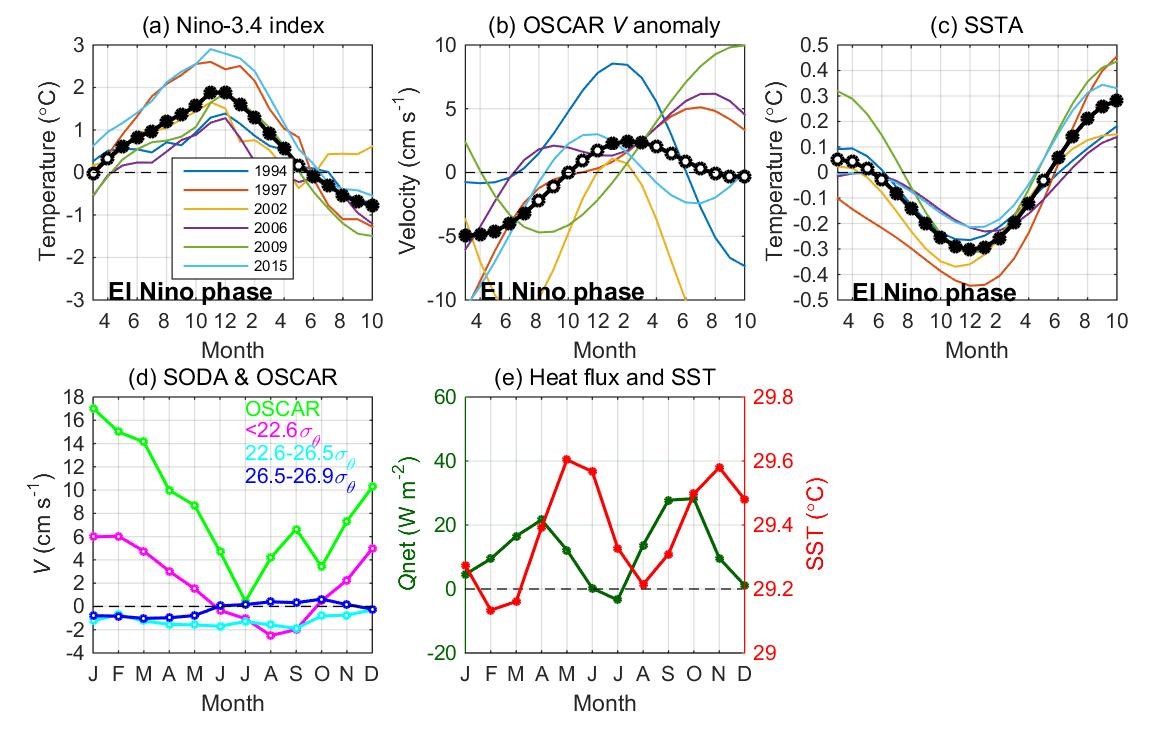The shallow meridional overturning circulation (MOC) is a primary component of the Pacific wind-driven circulation. Embedded within the subtropical cells that connect the tropical and subtropical ocean, the tropical MOC (TMOC) exists within the tropical ocean and consists of upwelling at the equator, a surface poleward flow, off-equatorial downwelling at ~5°, and an equatorial return flow in the thermocline. The TMOC acts as an important agent for heat exchange between the equatorial and off-equatorial ocean and thereby plays a significant role in the recharge–discharge regime of the El Ni?o–Southern Oscillation (ENSO). It is primarily driven by basin-wide easterly trade winds near the equator, forming a closed cell pair off the Pacific equator. The thermocline cold water brought by the lower branch of the TMOC feeds the eastward-flowing Equatorial Undercurrent (EUC) and affects the tropical Pacific sea surface temperature (SST) through equatorial upwelling. Therefore, variability in either the strength or temperature of the TMOC may exert a significant impact on the tropical Pacific climate.
However, neither the climatological structure nor the temporal variability of the Pacific TMOC is well documented due to the shortage of direct observations. The complex flow structure of the TMOC covers only a few degrees of latitude and therefore presents a challenge for in situ observation. As a result, existing knowledges of the TMOC were mainly established by synoptic cruise measurements and model simulations. It is of paramount need to verify and complement these knowledges by long-term, in situ observations with sufficient spatial and temporal resolutions.
In particular, most previous studies focused on the TMOC in the central-to-eastern Pacific basin, and very few observations are available for the western Pacific counterpart. Equatorial upwelling of the western Pacific TMOC may contribute to SST variability of the warm pool and atmospheric deep convection. It remains unknown whether the western Pacific TMOC shows behaviors similar to those of the basin-mean TMOC or whether its spatial-temporal characteristics are unique. Moreover, the effect of TMOC variability on regional SST has not yet been examined. The team leading by Professor Wang Fan studied the structure and variability of the northwest Pacific component of the TMOC and its impact on local SST.

Fig. Seasonal and interannual variabilities of TMOC and its impact on SST
According to their study with the aid of seven subsurface moorings deployed at 142°E during August 2014-October 2015, a sandwich structure of the tropical meridional overturning circulation (TMOC) was revealed between 0–6°N that consists of a surface northward flow (0–80 m), a thermocline southward fow (80–260 m; 22.6–26.5 σθ), and a subthermocline northward flow (260–500 m; 26.5–26.9 σθ). Based on mooring data, along with satellite and reanalysis data, prominent seasonal-to-interannual variations were observed in all three layers, and the equatorial zonal winds were found to be a dominant cause of the variations. The TMOC is generally stronger in boreal winter and weaker in summer. During 2014–2015, the TMOC was greatly weakened by westerly wind anomalies associated with the El Ni?o condition. Further analysis suggests that the TMOC can affect equatorial surface temperature in the western Pacific through anomalous upwelling/downwelling and likely plays a vital role in the El Ni?o-Southern Oscillation (ENSO).
Corresponding Author: Prof. Wang Fan, fwang@qdio.ac.cn. PIO of Institute of Oceanology, CAS: Ms.Yang Fengfan, fengfanyang@qdio.ac.cn
Link: https://www.nature.com/articles/s41598-018-26047-7
|
|

Address: 7 Nanhai Road, Qingdao, Shandong 266071, China
Tel: 86-532-82898902 Fax: 86-532-82898612 E-mail: iocas@qdio.ac.cn


